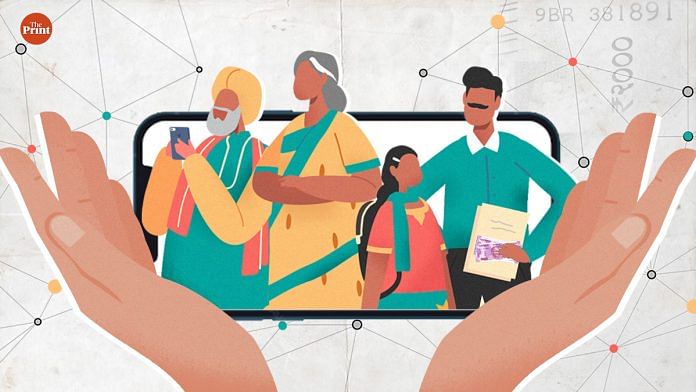Think Zomato or Swiggy but for social protection. This is the idea behind Social Protection-Open Digital Ecosystem, or SP-ODEs.
An SP-ODE can be thought of as a unified, digital platform to access welfare schemes spanning different departments of the government. It is a multi-sided platform, always involving the citizen and the government and, in more mature systems, also, service providers such as insurers, lenders. It provides beneficiaries with an app or a website that makes transparent all social protection benefits they are eligible for.
Further, they must no longer enroll into each social protection scheme individually to get the range of benefits due to them. Simultaneously, governments save money as individual departments migrate to a single, common enrolment process.
Also read: Can financial decisions be free of emotion? Why it’s not the case in Indian households
How it happens
A citizen database (also known as a social registry) allows for a one-time enrollment process which is shared across departments. This registry uses a legacy database such as Public Distribution System or the Census. Ideally, the registry would also allow for further enrichment to include those citizens who may have been left out of legacy databases.
Next, it authenticates citizens before registering them. Each authenticated citizen is allotted a unique identification anchored to the registry. Different government departments are allowed to use this registry to authenticate beneficiaries without requiring them to submit any additional paperwork.
These registries are being created in several Indian states and are operational in many others. For instance, in Rajasthan it is called Jan Aadhaar Data Repository, and in Madhya Pradesh, Samagra State Population Register.
How does building a registry help deliver social protection benefits?
Citizens can apply for schemes online after which government departments (or administrators) assess their applications. The administrators’ interface has additional functionalities which allows them to identify eligible beneficiaries and authenticate applicants.
In theory, this universal registry and the administrator interface together can also help surface new beneficiaries if circumstances warrant. For instance, using parents’ caste, the government can automatically generate a caste certificate for their new-born child without the parents having to apply for one. This is an example of proactive benefit delivery.
How are benefits transferred to beneficiaries?
Once the government has validated and approved the beneficiaries’ applications, they trigger cash benefit payments to them. The Direct Benefit Transfer (DBT) system is often integrated with the registry, which processes payment instructions. While the DBT system only helps in routing the money to the beneficiaries’ bank account, often additional infrastructure is needed for the beneficiaries to withdraw that money from the bank account. This is typically facilitated through business correspondents (BCs) who serve as extended bank branches and provide services such as cash-in, cash-out.
Another important last-mile touchpoint for social protection is the Common Service Centre instituted at gram panchayat level to provide services such as enrollment for identification documents or collecting premiums for insurance schemes.
Similarly, non-cash benefits such as ration are also distributed through physical touch points such as PDS shops.
What if the beneficiary faces challenges in enrolling for or receiving benefits?
While designing a multi stakeholder platform with several hand-off points, it is imperative to design effective grievance redress mechanisms. Research suggests that crowding in and analysing grievances from citizens and other stakeholders can address specific grievances and shine light on gaps in the system.
An effective grievance redress channel would be easy to access, place a low burden of proof on the citizen, proactively share the status of complaints with citizens and automatically escalate unresolved matters.
Is exclusion a thing of the past, with SP-ODEs on the horizon or in action?
Not really. Our work on digitisation at the last mile suggests that the realisation of these opportunities depends on the governance framework within which SP-ODEs operate.
In the absence of a strong legal and governance framework, these opportunities could be overwhelmed by attendant risks. These risks include exclusion due to digitisation and black box algorithms, difficulties that citizens face in holding the system accountable and breach of privacy due to mishandling of personal data.
For SP-ODEs to move the needle on inclusive social protection, a careful examination of risks posed to citizens and incorporating measures that avert and minimise them are critical.
Beni Chugh is Research Manager, Future of Finance Initiative, at Dvara Research.
The article is part of our new series of financial explainers in partnership with Dvara Research.
Views are personal.
Also read: Despite direct benefit transfers, welfare schemes beneficiaries still floundering, claims study



